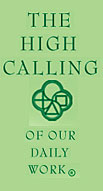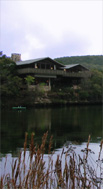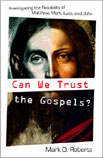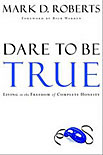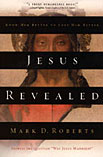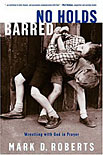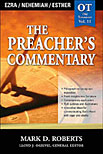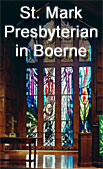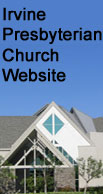My blog has moved! http://www.patheos.com/blogs/markdroberts/
|
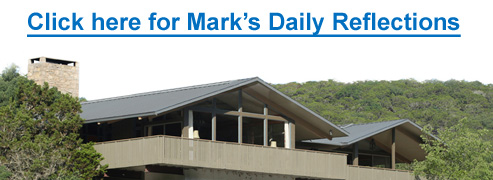 |
Twitter Feed for My Recent Blog Posts and Other Tweets |
My blog has moved! http://www.patheos.com/blogs/markdroberts/
|
Advent Calendar for December 1
By Mark D. Roberts | Tuesday, December 1, 2009
 Click here to see today’s Advent calendar entry
Click here to see today’s Advent calendar entry
Topics: Advent Calendar | 1 Comment »
Growing Closer to God in Advent: Some Practical Suggestions
By Mark D. Roberts | Tuesday, December 1, 2009
Part 4 of series: Introduction to Advent
Permalink for this post / Permalink for this series
So far in this series I’ve explained what Advent is and why I have found it helpful to observe Advent. If you’re at all convinced, you may wonder what to do about it. In this post and the next in this series I’ll outline some practical suggestions for how you might experience Advent.
Pay Attention to the Advent Content of Corporate Worship
If your church celebrates Advent, be ready to pay close attention to the readings, prayers, songs, and seasonal pageantry (like the lighting of the Advent wreath). Your intentionality in worship can infuse your whole life with Advent expectation.
Many churches, even if they don’t plunge into the spirit of Advent, nevertheless wade into Advent themes in their pre-Christmas worship. They use readings from the Old Testament prophets or sing Advent carols like “O Come, O Come, Emmanuel.” The more you pay attention to these Advent elements, the more your personal experience will be enriched.
If your church doesn’t acknowledge Advent, you may decide to talk with your pastor or worship leader about it. But, please, be kind and encouraging! Throughout my years as a parish pastor, I found it much easier to receive “Here’s something I find exciting!” than “Here’s what you’re doing wrong!”
Enjoy Advent Music
This isn’t quite as easy as it sounds, unfortunately. There are hundreds of popular Christmas songs and carols, played everywhere during Advent, from churches, to gas stations and shopping malls. There are comparatively few Advent songs, though many songs and carols do touch upon Advent themes of waiting, hoping, and yearning for God.
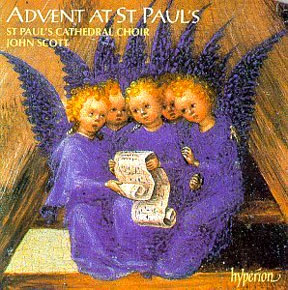 If you enjoy classical music, there are a few Advent albums available, including:
If you enjoy classical music, there are a few Advent albums available, including:
Advent at St. Paul’s. This is my current favorite of the bunch.
The first part of the so-called “Christmas portion” Handel’s Messiah is filled with Advent themes (from the beginning through “The People That Walked in Darkness”). This is probably the most readily available and familiar classical Advent music. My favorite recording of the Messiah is the Academy of Ancient Music version conducted by Christopher Hogwood.
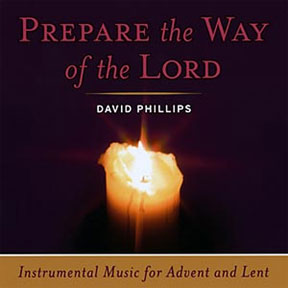 I have found one more contemporary Advent CD. Actually, it combines Advent music with Lenten music. Prepare the Way of the Lord by David Phillips contains 18 instrumental tracks, half dedicated to Advent, the other half dedicated to Lent. This is a wonderful collection of music by an accomplished Christian pianist. You can purchase the CD from Amazon, or you can download an MP3 version from David Phillips’ website.
I have found one more contemporary Advent CD. Actually, it combines Advent music with Lenten music. Prepare the Way of the Lord by David Phillips contains 18 instrumental tracks, half dedicated to Advent, the other half dedicated to Lent. This is a wonderful collection of music by an accomplished Christian pianist. You can purchase the CD from Amazon, or you can download an MP3 version from David Phillips’ website.
I listen to quite a bit of Christmas music in Advent, but try to stick with instrumental versions. Thus I save listening to sung Christmas carols for Christmas Eve and thereafter. This way I still have a sense of waiting even while listening to familiar carols.
Use an Advent Wreath in Your Home
You can get Advent wreath kits online or from most Christian bookstores. But you can easily make your own with a wreath (natural or artificial) and five candles. See this example of the Advent wreath in my home.
If you aren’t sure what to do with an Advent wreath, I’ve written a guide that you can access by clicking here. Feel free to adapt it as you see fit, or to use it in ministry settings.
Finally, if you want to experience a virtual lighting of the candles of the Advent wreath, you can visit my website each Sunday. Click here for last week’s online lighting.
Let Your Nativity Scene Function as an Advent Calendar
I have not done this before, but I have friends who do. They have nativity scenes with lots of characters. They time the setting up of their nativity scene so that they add one character each day, adding the Christ child on Christmas (or Christmas Eve). This can also be a wonderful family tradition that involves each member, especially younger children.
 Dress for Advent
Dress for Advent
It’s common for people to wear Christmas colors throughout the month of December, so why not Advent colors? I used to do this when I led worship at Irvine Presbyterian Church, wearing a purple tie in the more traditional services and a purple sweater in the contemporary services. These days, I wear purple ties to work during the first part of Advent, before I transition to Christmas ties (which I won’t get to wear unless I use them in the days leading up to Christmas).
Focus in Your Personal Devotions on Advent Themes
There are many texts, both in the Old Testament and New Testament, that express Advent themes. By reading and meditating on these passages you’ll enhance your Advent experience of God. Some possibilities for Advent Bible readings can be found in my Advent wreath guide.
Tomorrow I’ll add one more way to observe Advent. This I count as my greatest Advent discovery. Stay tuned . . . .
Topics: Advent | 3 Comments »
Why Advent?
By Mark D. Roberts | Monday, November 30, 2009
Part 3 of series: Introduction to Advent
Permalink for this post / Permalink for this series
In my last post, I told the story of my Advent beginnings. When I started out as pastor of Irvine Presbyterian Church in 1991, for the first time in my life, I began to see Advent as a distinct season of the year and to experience its richness.
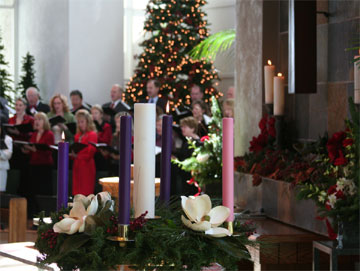 In the years following my Advent beginnings, my appreciation of Advent grew slowly and steadily. At some point I became aware of the purple and pink Advent color scheme, something we had not previously emphasized at Irvine Presbyterian Church. I remember when, sometime in the 1990s, we started using three purple and one pink candle in the church Advent wreath. It was a change for church members, who had been used to all white candles. Of course a few people made sure I knew they missed the “beautiful white candles.” But soon our whole church appreciated the connotations of the colors. (Photo: The Advent wreath on the chancel of the sanctuary at Irvine Presbyterian Church)
In the years following my Advent beginnings, my appreciation of Advent grew slowly and steadily. At some point I became aware of the purple and pink Advent color scheme, something we had not previously emphasized at Irvine Presbyterian Church. I remember when, sometime in the 1990s, we started using three purple and one pink candle in the church Advent wreath. It was a change for church members, who had been used to all white candles. Of course a few people made sure I knew they missed the “beautiful white candles.” But soon our whole church appreciated the connotations of the colors. (Photo: The Advent wreath on the chancel of the sanctuary at Irvine Presbyterian Church)
I decided to go “whole hog” with Advent colors one year. I wore mostly purple ties during Advent. I put up an “Advent tree” in my office at church, which could be seen from the busy street in front of the church. I didn’t outlaw the use of Christmas colors in our sanctuary or anything like that, though our paraments on the communion table and pulpit were purple. I’m sure some folks thought I’d lost a few of my marbles in my zeal for Advent colors, but, for me, it was a chance to emphasize Advent in my personal life as well as in my ministry.
Why did Advent matter so much to me? Among many reasons, two stand out. First, I found that observing Advent enriched my celebration of Christmas. Taking four weeks to focus on the hope of Christ’s coming made me much more joyful when I finally got to celebrate it. The more I got in touch with my need for a Savior, the more I rejoiced at the Savior’s birth.
Second, I found in Advent a solution to the age-old problem of secular Christmas vs. spiritual Christmas. If you’re a Christian, you know what I mean. We recognize that Christmas is, most of all, a time to celebrate the birth of Jesus. It’s a holiday that focuses on the meaning of the Incarnation. Yet, given the secular traditions of Christmas, we spend most of our time preparing, not for a celebration of the birth of Jesus, but for fulfilling the demands of the season. We have to buy lots of presents for lots of people and make sure they are all wrapped and delivered. We have parties to attend and parties to host. We have relatives who come to visit or, alternatively, we are the relatives who go elsewhere to visit. This requires lots of planning, not to mention the energy required for holiday travel. We have to send out Christmas cards, making sure our addresses are right and that they get on all the envelopes. If we have younger children, we may very well spend hours trying to assemble gifts that come with sketchy instructions written by someone for whom English is, at best, a third language. And so on, and so on, and so on.
Meanwhile, we hear our Christian leaders telling us that we’re spending too much time and money in secular celebrations and not focusing enough on the real meaning of Christmas. Religious posters proclaim: “Jesus is the reason for the season.” But, in fact, Jesus faces heavy competition from retailers, relatives, and revelers. So what’s a Christian to do?
In my idealistic twenties, I thought about downsizing my celebrations of Christmas. At one point I tried to convince some friends and family members that we should make Christmas an entirely “spiritual” holiday, one in which we focus only on the birth of Jesus. Not wanting to be the Grinch, however, I didn’t abandon secular festivities or gift giving. “Let’s do that stuff on New Year’s Eve,” I argued. “Not only is this holiday very close to Christmas, but also, if we give gifts on New Year’s, we’ll be able to shop in the post-Christmas sales and that will save a lot of money.” Ah, what logic! But nobody was persuaded, least of all my family members. The secular and familial Christmas traditions were too embedded in our lives and, I might add, greatly loved. So I abandoned my effort to de-secularize Christmas. (In retrospect, I rather think I wouldn’t have liked doing what I proposed. I too, you see, am a lover of Christmas traditions.)
As I entered my thirties, I tried to emphasize the Christian aspects of Christmas in the days leading up to the holiday. But I seemed to be fighting a losing battle. I needed some way to focus my mind and heart. And I needed some new traditions that would help me. Then I discovered Advent. For some reason, observing Advent during December helped me to draw near to God in a way that I had not been able to do before. I still engaged in the secular celebrations of Christmas, happily so, I might add. But I also added several new practices that tuned my heart to resonate with the deeper meaning of the coming of Christ.
I know that many others have had a similar experiences to mine. Since 2004 I have been blogging about Advent. During the past five years I have received dozens of emails from people who have shared their own excitement for Advent. Some have grown up with Advent traditions. Most have “discovered” Advent later in life, much as I did. All have found that observing Advent enriches their celebration of Christmas and allows them to have a precious, peaceful, God-focused experience during what is often a hectic holiday season.
In my next post I’ll describe some of the Advent practices that I have found to be most helpful.
Topics: Advent | 2 Comments »
Advent Devotional: The Lighting of the First Candle
By Mark D. Roberts | Sunday, November 29, 2009
This is an excerpt from my Advent Devotional Guide that uses the Advent wreath. If you have a real wreath, you can use it, either alone, or with others. If you don’t have a wreath, follow this guide, and you can “light” the Advent candle for today online. (I originally wrote this guide for families at Irvine Presbyterian Church.)
Introduction to Advent
Advent is a season of waiting, expecting, and hoping. Beginning four Sundays prior to Christmas and ending on Christmas Eve, Advent helps us to prepare for the coming, or “advent” of the Christ child at Christmas. (The word “advent” comes from the Latin word that means “coming.”)
For hundreds of years Christians have used an Advent wreath to inspire their hopes for the coming of Christ. By lighting candles and reading Bible verses, we are reminded about the meaning of Christ’s birth and become more excited about his coming in the past, in the future, and in our own lives.
There is no set meaning for the candles of the Advent wreath (except for the middle candle, which always signifies the birth of Jesus the Christ). Some wreaths use all white candles; others use three purple candles, one pink candle, and one white candle in the middle. The purple candles remind us of how serious and solemn God’s people have been in waiting for the Messiah. The pink signifies the joy of our waiting. The white is triumphant and celebrative because Christ is born.
What follows is a guide for personal worship that can accompany the lighting of the candles of the Advent wreath. You can do this on your own with a real Advent wreath. Or you can do this online by “lighting” the wreath through appropriate clicking. Or you can use this guide with your family, which might certainly include friends. All families are different, and I encourage you to adapt or to change what is suggested — or do something completely original. Parents will want to make changes to fit the developmental stages of their children.
Speaking of children, they have great expectations and hopes during Advent — usually associated with Christmas presents, Santa Claus, holiday celebrations, and so forth. Rather than discouraging these hopes (which is a “hopeless” task!), I would urge you to help your children get the “feel” of Advent by relating their hopes to biblical Advent themes.
I pray that this guide will help you prepare for the coming of the Christ child!
The Beginning of Week 1: We Remember the Meaning of Advent
Advent is a word that means “coming” or “visit”. In the Christian season of Advent we prepare for the “advent” of Christ at Christmas. Our preparation includes many things:
• We remember Israel’s hope for the coming of God’s Messiah to save, to forgive, and to restore them.
• We remember our hope for the second coming of Jesus.
• We remember our need for a Savior to save us from our sins.
• We prepare to welcome Christ at Christmas into our world . . . and into our hearts.
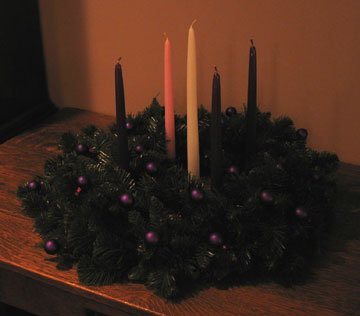 By lighting one candle each week of Advent, we help ourselves to get ready for the birth of Jesus. The candles have different meanings, each based upon the Bible. These meanings help us to understand how special the birth of Jesus is for us.
By lighting one candle each week of Advent, we help ourselves to get ready for the birth of Jesus. The candles have different meanings, each based upon the Bible. These meanings help us to understand how special the birth of Jesus is for us.
Today we focus on the coming of Christ as our Shepherd.
Prayer for God’s Help
Dear God, thank you for this season of Advent that helps us to prepare for the coming of Christ at Christmas. As we read the Bible and light a candle, may excitement for Christ’s coming burn in our hearts. Amen.
Topics: Advent | 2 Comments »
Advent Beginnings
By Mark D. Roberts | Saturday, November 28, 2009
Part 2 of series: Introduction to Advent
Permalink for this post / Permalink for this series
In yesterday’s post, I explained the timing and purpose of Advent, as well as its unexpected color scheme. I closed by noting that Advent is growing in popularity, especially among Protestant Christians who, in many cases, did not grow up with much awareness of Advent.
I fall into that category. Though, as I noted in my last post, I enjoyed paper Advent calendars in my youth, I did not think of Advent as a season of the Christian year. In fact, I had no idea that Christians even had a year with special seasons. At the First Presbyterian Church of Hollywood where I grew up, we celebrated Christmas and Easter, and that was about it. The weeks of December prior to Christmas were Christmastime, not Advent.
 When I was a teenager, Lloyd Ogilvie came as Senior Pastor of Hollywood Pres. He brought with him the tradition of using an Advent wreath in worship services prior to Christmas. Though we continued to sing Christmas carols and decorate the sanctuary with Christmas colors, Dr. Ogilvie did, however, speak of Advent as a season of preparation for Christmas. Still, I thought of Advent mostly as Christmas-lite, and not as a distinct season with distinct emphases. (Photo: First Presbyterian Church of Hollywood on Christmas Eve 2007)
When I was a teenager, Lloyd Ogilvie came as Senior Pastor of Hollywood Pres. He brought with him the tradition of using an Advent wreath in worship services prior to Christmas. Though we continued to sing Christmas carols and decorate the sanctuary with Christmas colors, Dr. Ogilvie did, however, speak of Advent as a season of preparation for Christmas. Still, I thought of Advent mostly as Christmas-lite, and not as a distinct season with distinct emphases. (Photo: First Presbyterian Church of Hollywood on Christmas Eve 2007)
While I was preparing for ordination in the Presbyterian Church, I took a course in “polity” (church order) at Fuller Theological Seminary. The professor, Dr. Gary Demarest, lectured on a section of the PC(USA) Book of Order that focused on worship. In this lecture, he spoke with zeal about the “Church Year” and its various seasons. These included: Advent, Christmas, Epiphany, Lent, Holy Week, Easter, and Pentecost. Dr. Demarest talked excitedly about how the seasons of the Church Year could enrich the worship of a church as well as one’s private devotions. I had never heard anything like this. I was intrigued, but didn’t do much with what I learned at that time. I was serving on the staff at Hollywood Pres, where we continued to use an Advent wreath in our pre-Christmas worship services, but otherwise didn’t do much with Advent.
My first full exposure to Advent came when I began as Senior Pastor of Irvine Presbyterian Church in 1991. It all started with a complaint, of all things. Funny how that happens in church! Sometime in November, a member of the church came to me to let me know how unhappy she was that “Loren doesn’t let us sing Christmas carols until Christmas Eve.” I asked why Loren, our worship director at the time, had this peculiar proscription. “Because he’s into Advent,” the woman explained. “He wants to sing only Advent songs during Advent.”
What I heard about Loren seemed odd to me for many reasons, partly because I could only think of two Advent hymns: “Come, Though Long Expected Jesus” and “O Come, O Come Emmanuel.” It was hard to imagine four weeks of nothing but these songs, as wonderful as they may be.
When I talked with Loren, I learned that the complaint I had heard was only partly true. Apparently, in years past, Loren had virtually outlawed Christmas music during Advent. He reserved the beloved carols for Christmas Eve and the twelve-day season of Christmas that ended on January 6. But when many people in the congregation let Loren know how much they missed singing Christmas carols prior to Christmas, he relented. Now his plan was to start Advent with music that was Advent-themed, and slowly include Christmas carols in the Sundays prior to Christmas. A few carols, however, like “Joy to the World,” were reserved for Christmas Eve and thereafter. (This was ironic, because “Joy to the World” was not actually written as a Christmas carol. See my article in Worship Leader magazine.)
As I spoke with Loren, reassured that he wasn’t banning Christmas music altogether before Christmas Eve, I listened to his passion for Advent and the possibilities of our worship and devotional life being enriched by observing this season. I was excited by the potential and eager to experience a more intentional and complete Advent season.
During my first Advent at Irvine Presbyterian Church, I did find it odd to sing relatively few Christmas carols before Christmas Eve. And I did find much of the Advent music to be unfamiliar. We used the Advent wreath in worship, with its expressions of expectation and hope. Though I missed some of what I had always associated with the build up to Christmas, I found that Advent did indeed heighten my yearning for the coming of Christ, and it did indeed help me to experience Christmas in a deeper way.
Christmas of 1991, my first at Irvine Presbyterian Church, was the beginning of my becoming an Adventophile . . . an Advent lover.
In my next post in this series, I’ll share more of what I learned about Advent. Tomorrow, however, my post will be a special Advent devotional.
Topics: Advent | 1 Comment »
Advent Approaches . . .
By Mark D. Roberts | Friday, November 27, 2009
Part 1 of series: Introduction to Advent
Permalink for this post / Permalink for this series
This coming Sunday is the first day of Advent. If you’ve been reading my blog for more than a year, you know that I generally make a big deal out of Advent. If you’re new to my blog, however, you may wonder why I bother. My goal in this post is to explain what Advent is. My next post in this series will make the case for taking Advent seriously.
When is Advent?
Advent is a Christian season that lasts for about four weeks. It begins four Sundays before Christmas and ends on Christmas Eve, thus there is some variation in its length. (If you’re unfamiliar with the idea of Christian seasons, you might find helpful a few pieces I’ve written: “Overview of the Christian Year,” “The Colors of the Christian Year,” and “The Christian Year and the Textures of Worship.”) I should mention that Eastern Orthodox Christians do not recognize Advent per se, but have a longer season that is rather like Advent. Their Nativity Fast begins in the middle of November and is a season for repentance and abstinence.
In our secular American celebration of Christmas, the Christmas season (or holiday season, ugh) begins in the weeks prior to Christmas Day. Generally, this season starts in early December, though retailers have a bad habit of beginning Christmas in November (or even October). In my rule book, you shouldn’t listen to Christmas music or turn on Christmas lights until after you’ve finished the Thanksgiving turkey . . . at the earliest. Of course outside of my immediate family, nobody follows my rules . . . especially retailers.
What is Advent?
The Christian season of Christmas actually begins on Christmas Eve and lasts for twelve days, ending on January 6. (No, the twelve-day season of Christmas did not start with the song. It was the other way around.) The time before Christmas is Advent, a season of preparation for Christmas. Christians prepare for celebrating the birth of Jesus by remembering the longing of the Jews for a Messiah. In Advent we’re reminded of how much we ourselves also need a Savior, and we look forward to our Savior’s second coming even as we prepare to celebrate his first coming at Christmas. Indeed, the word Advent comes from the Latin word adventus that means “coming” or “visit.” In the season with this name, we keep in mind both “advents” of Christ, the first in Bethlehem and the second yet to come.
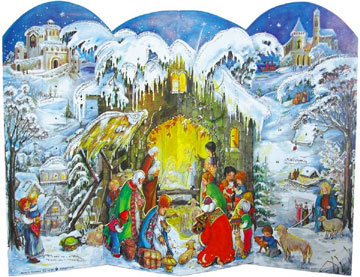 If you’re unfamiliar with Advent, I expect it might feel odd to think of the weeks before Christmas as something more than Christmastime. For most of my life, Advent played very little role in my pre-Christmas consciousness. As a child, I did have Advent calendars: sturdy, decorative paper displays with 25 little “windows,” one of which I would open each day of December leading up to Christmas. My Advent calendar was a way to whet my appetite for Christmas, not that I needed much help to get ready for my favorite day of the year, mind you. I loved Christmas when I was young, partly because it celebrated the birth of Jesus, but mostly because it was a giant party in which I received lots of presents. In a sense, the Christian observance is a bit like my boyhood Advent calendars, though it has a much more serious purpose. It’s meant to get us ready, not for a present-opening party, but for a transformational celebration of the birth of Jesus.
If you’re unfamiliar with Advent, I expect it might feel odd to think of the weeks before Christmas as something more than Christmastime. For most of my life, Advent played very little role in my pre-Christmas consciousness. As a child, I did have Advent calendars: sturdy, decorative paper displays with 25 little “windows,” one of which I would open each day of December leading up to Christmas. My Advent calendar was a way to whet my appetite for Christmas, not that I needed much help to get ready for my favorite day of the year, mind you. I loved Christmas when I was young, partly because it celebrated the birth of Jesus, but mostly because it was a giant party in which I received lots of presents. In a sense, the Christian observance is a bit like my boyhood Advent calendars, though it has a much more serious purpose. It’s meant to get us ready, not for a present-opening party, but for a transformational celebration of the birth of Jesus.
What Colors Are Used in Advent?
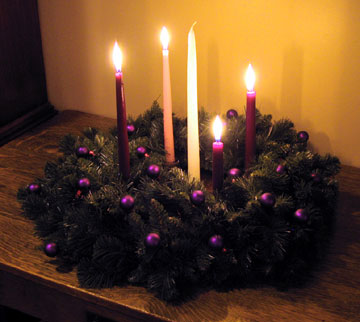 There are a few other things about Advent that you might find odd if you’re unfamiliar with them. The strangest might be the Advent color scheme. We associate Christmas and the weeks leading up to it with typical Christmas colors: red, green, white, silver, and gold. Advent, on the other hand, features purple (or dark blue) and pink. The purple/blue color signifies seriousness, repentance, and royalty. Pink points to the minor theme of Advent, which is joy. The first, second, and fourth Sundays of Advent are “purple/blue” Sundays. Only the third is a “pink” Sunday. The pink, joyful color reminds us that, even as Advent helps us get in touch with our sober yearning for God to come to us, we know that he did in fact come in the person of Jesus. Thus our minor-themed waiting has a grace note of joy mixed in. If you’ve seen a traditionally-colored Advent wreath will recognize the purple and pink colors of this season (with the central, white, Christ-candle for Christmas Eve/Day). But if you’re unfamiliar with Advent and happen to attend a church service in early December in a church that recognizes Advent, you might be startled to see lots of purple, a bit of pink, and no red or green. (Many churches combine the colors of Advent and Christmas, however, so visitors won’t be completely perplexed.)
There are a few other things about Advent that you might find odd if you’re unfamiliar with them. The strangest might be the Advent color scheme. We associate Christmas and the weeks leading up to it with typical Christmas colors: red, green, white, silver, and gold. Advent, on the other hand, features purple (or dark blue) and pink. The purple/blue color signifies seriousness, repentance, and royalty. Pink points to the minor theme of Advent, which is joy. The first, second, and fourth Sundays of Advent are “purple/blue” Sundays. Only the third is a “pink” Sunday. The pink, joyful color reminds us that, even as Advent helps us get in touch with our sober yearning for God to come to us, we know that he did in fact come in the person of Jesus. Thus our minor-themed waiting has a grace note of joy mixed in. If you’ve seen a traditionally-colored Advent wreath will recognize the purple and pink colors of this season (with the central, white, Christ-candle for Christmas Eve/Day). But if you’re unfamiliar with Advent and happen to attend a church service in early December in a church that recognizes Advent, you might be startled to see lots of purple, a bit of pink, and no red or green. (Many churches combine the colors of Advent and Christmas, however, so visitors won’t be completely perplexed.)
Advent’s Growing Popularity
Advent doesn’t get much attention compared to Christmas, though interest in Advent is growing steadily in many churches and in many Christian homes. That’s not to say everybody is an “Adventophile,” a lover of Advent, however. Some Protestants ignore Advent because it isn’t taught in Scripture and because they associate it with Roman Catholicism. Secular culture ignores Advent because there isn’t much money to be made here. I suppose you might be able to make a few bucks selling purple and pink candles, but this isn’t going to thrill most retailers.
I think there are lots of good reasons to pay more attention to Advent, however. I’ll begin to explore these in my next post in this series.
Topics: Advent | 1 Comment »
Thanksgiving
By Mark D. Roberts | Thursday, November 26, 2009
Enter his gates with thanksgiving;
go into his courts with praise.
Give thanks to him and praise his name.
On this Thanksgiving Day, we Americans are encouraged to pause and give thanks to God. In his Thanksgiving Proclamation of 1863, President Abraham Lincoln wrote: “The year that is drawing toward its close has been filled with the blessings of fruitful fields and healthful skies. To these bounties, which are so constantly enjoyed that we are prone to forget the source from which they come, others have been added which are of so extraordinary a nature that they can not fail to penetrate and soften even the heart which is habitually insensible to the ever-watchful providence of Almighty God.”
As you may recall, in 1863 the United States was in the Civil War, a terribly brutal and emotionally horrifying experience. Thousands of young Americans had died, while others faced the prospect of imminent death. Yet, in the midst of such a challenging time, President Lincoln called upon Americans to remember the richness of God’s blessings, and to be thankful.
So it should be with us. In many ways, 2009 has not been an easy year for our nation. Economic hardships have touched millions of lives. Wars in Iraq and Afghanistan continue to take thousands of men and women away from their homes, and some of these brave soldiers will never return. In countless other ways, we in this nation have struggled in 2009.
Thus we need to hear the encouragement of Abraham Lincoln again. In spite of our challenges and setbacks, we have been richly blessed by God in this country. Thanksgiving is due just as much today as it was in 1863, perhaps much more.
When we give thanks, we bring to mind God’s gifts to us. This, in turn, reminds us of God’s gracious nature. We think, not just of what God has done, but also of who God is. Thus, thanks is a point of entry to praise. In the language of Psalm 100, we enter God’s gates with thanksgiving, so that we might go into his courts with praise. There’s no biblical rule that states that thanks must come before praise. But, for many of us, thanksgiving for what God has done leads us to praise God for who he is.
So, may you enter God’s gates with thanksgiving today, so that you might celebrate in his courts with praise! May God give you a rich and blessed Thanksgiving Day!
QUESTIONS FOR REFLECTION: How is it possible to give thanks even in hard times? Does thanking God lead to praising God in your life?
PRAYER: Thank you, gracious God, for your abundant gifts to me. Thank you for giving me, not what I deserve, but so very much more. Thank you, most of all, for the gift of life you have given me through Christ. Thanks for the incredible privilege of knowing you and living my life in relationship with you, both now and forever.
All praise be to you, O God, giver of all good gifts! All praise be to you, because your grace and mercy are without end! All praise be to you for the gift of life in this world, and life forever in the age to come! All praise to you, O God, through Jesus Christ our Lord, Amen!
Topics: Thanksgiving | No Comments »
And Don’t Forget to Thank People Too!
By Mark D. Roberts | Wednesday, November 25, 2009
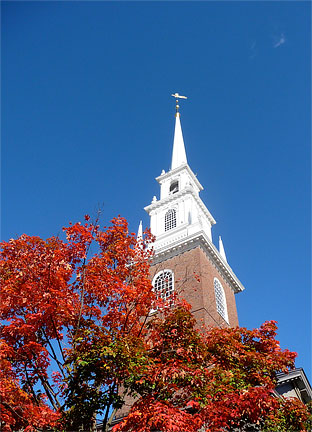 I’ll never forget something I heard at the baccalaureate service that was part of my graduation from college. As I sat in the Memorial Church of Harvard University, the President of Radcliffe College (part of Harvard) said something like, “The baccalaureate service is a traditional ceremony of thanks and praise.” Wow, I thought, that’s surprisingly good! But then the President continues, “So, on this day, we keep the tradition of baccalaureate by thanking you for being part of this university and praising you for your outstanding achievements.” Oops! She got the thanks and praise part right, but rather confused who receives them. The traditional baccalaureate service features thanks and praise to God, not the graduates! (Photo: The steeple of Memorial Church.)
I’ll never forget something I heard at the baccalaureate service that was part of my graduation from college. As I sat in the Memorial Church of Harvard University, the President of Radcliffe College (part of Harvard) said something like, “The baccalaureate service is a traditional ceremony of thanks and praise.” Wow, I thought, that’s surprisingly good! But then the President continues, “So, on this day, we keep the tradition of baccalaureate by thanking you for being part of this university and praising you for your outstanding achievements.” Oops! She got the thanks and praise part right, but rather confused who receives them. The traditional baccalaureate service features thanks and praise to God, not the graduates! (Photo: The steeple of Memorial Church.)
Similarly, the primary purpose of Thanksgiving Day is to express gratitude to God for his many gifts. Although sometimes this gets forgotten in our secular culture today, still most people realize that our thanksgiving should be directed most of all in God’s direction.
However, this season of year also gives us a chance to say thanks to others. We can express our gratitude to the people in our lives for whom we are grateful, and who sometimes don’t get to hear this from us very much. As long as I’m thanking the Lord for my wife, my children, etc. etc., doesn’t it make sense to tell them?
We see an example of this sort of thing in the letters of the Apostle Paul. On several occasions he not only thanks God for his churches, but he tells them of it. Consider Paul’s letter to the Thessalonians Christians, for example. Here we read:
We always give thanks to God for all of you and mention you in our prayers, constantly. (1:2)
How can we thank God enough for you in return for all the joy that we feel before our God because of you? (3:9)
Imagine how you’d feel to hear this from someone important in your life. My guess is you’d feel honored, happy, maybe a bit embarrassed, and even thankful. It’s a wonderful thing to hear that someone is truly thankful for you. In fact it’s one of the best feelings in life.
Thanksgiving provides a salutary occasion for saying thanks, both to the God from whom all blessings flow and to those who are conduits of divine blessings in our lives. It’s a time to stop what we’re doing and say “Thank you” to the people in our lives who deserve to hear this from us. Even if you manage to thank only one other person this Thanksgiving, that small gesture can make a big difference in the life of that person.
So, may I encourage you to use the occasion of Thanksgiving to thank the people in your life who matter to you. Tell people that you’re thankful for them. Drop someone a note. Or make a short phone call. If they’re under twenty, you can even text them! Telling people that you’re thankful for them will enrich your life as well as the lives of those for whom you are grateful.
Topics: Thanksgiving | 2 Comments »
A Brief History of Thanksgiving
By Mark D. Roberts | Tuesday, November 24, 2009
For several years, it has been my history to put up a bit of Thanksgiving history during the week prior to the holiday. So, once again, here is a brief history of Thanksgiving.
Severnal years ago I asked my six-year-old nephew, “On Thanksgiving, to whom do we say thank you?” He quickly responded, “To the native Americans.” (No, I’m not kidding.) “Do we say thank you to anybody else?” I queried persistently. “To the Pilgrims.” “And to anybody else?” I prodded further. “To God!” he exclaimed.
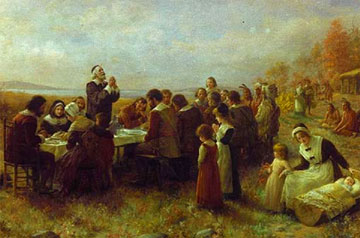
Well, though his order may be a little curious, that just about nails the historical roots of Thanksgiving. It’s common knowledge that the American celebration has its origin in 1621, as the Pilgrims invited the neighboring Indian tribes to join them in a feast of gratitude for God’s blessings. There’s no evidence, however, that they actually celebrated this on the fourth Thursday in November, or that it lasted only one day, or that they played a mean game of touch football after dinner. (Note: Ed Boyce comments that the first official Thanksgiving in the New World happened, not in New England, but in Virginia. Check out this link for the evidence. More discussion of the issue of the first Thanksgiving here.) (Picture: “The First Thanksgiving” by Jennie August Brownscombe, 1914)
New Englanders remembered the Pilgrims’ effort for many years through regional celebrations of Thanksgiving. Sometimes American Presidents would set aside a day for the nation to be thankful. In 1789, for example, President George Washington proclaimed November 26th as a national day of thanksgiving. Here’s the core of his presidential proclamation:
Whereas it is the duty of all Nations to acknowledge the providence of Almighty God, to obey his will, to be grateful for his benefits, and humbly to implore his protection and favor–and Whereas both Houses of Congress have by their Joint Committee requested me “to recommend to the People of the United States a day of public thanksgiving and prayer to be observed by acknowledging with grateful hearts the many signal favors of Almighty God, especially by affording them an opportunity peaceably to establish a form of government for their safety and happiness.”
Now therefore I do recommend and assign Thursday the 26th day of November next to be devoted by the People of these States to the service of that great and glorious Being, who is the beneficent Author of all the good that was, that is, or that will be–That we may then all unite in rendering unto him our sincere and humble thanks–for his kind care and protection of the People of this country previous to their becoming a Nation–for the signal and manifold mercies, and the favorable interpositions of his providence, which we experienced in the course and conclusion of the late war–for the great degree of tranquility, union, and plenty, which we have since enjoyed–for the peaceable and rational manner in which we have been enabled to establish constitutions of government for our safety and happiness, and particularly the national One now lately instituted, for the civil and religious liberty with which we are blessed, and the means we have of acquiring and diffusing useful knowledge; and in general for all the great and various favors which he hath been pleased to confer upon us.
And also that we may then unite in most humbly offering our prayers and supplications to the great Lord and Ruler of Nations and beseech him to pardon our national and other transgressions–to enable us all, whether in public or private stations, to perform our several and relative duties properly and punctually–to render our national government a blessing to all the People, by constantly being a government of wise, just, and constitutional laws, discreetly and faithfully executed and obeyed–to protect and guide all Sovereigns and Nations (especially such as have shown kindness unto us) and to bless them with good government, peace, and concord–To promote the knowledge and practice of true religion and virtue, and the increase of science among them and Us–and generally to grant unto all mankind such a degree of temporal prosperity as he alone knows to be best.
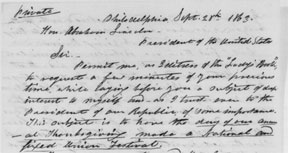
The idea of a permanent, national celebration each November came 242 years after the first Pilgrim-Indian festival in the early 17th century. During the Civil War, many Americans clamored for some sort of national religious holiday. One of the most vocal was Sarah Josepha Hale (who, by the way, wrote “Mary Had a Little Lamb”). Hale used her clout as editor of the influential Godey’s Lady’s Book magazine to motivate President Lincoln to proclaim a national holiday. On September 28, 1863 she wrote a letter to the President encouraging him to “have the day of our annual Thanksgiving made a national and fixed Union Festival.” Five days later Lincoln issued the “Thanksgiving Proclamation of 1863” (which we’ll examine below). (Picture: The first part of Hale’s letter to Lincoln. The underlined part reads “have the day of our annual Thanksgiving made a national and fixed Union Festival.”)
In his proclamation, Lincoln set apart the “last Thursday of November” as “a day of thanksgiving and praise to our beneficent Father who dwelleth in the heavens.” Throughout the next eight decades, all American Presidents followed Lincoln’s example. But during 1933, as the Great Depression raged, many merchants appealed to President Franklin D. Roosevelt to change the day from the last Thursday in November to the fourth Thursday. The reason for this request? November, 1933 had five Thursdays, which left the minimum number of shopping days between Thanksgiving Day and Christmas Day. Roosevelt denied this request, leaving the holiday on the last Thursday of the month.
But in 1939, the next five-Thursdays-in-November year, President Roosevelt gave in to the requests of business owners and established the fourth Thursday of November as Thanksgiving Day. National chaos ensued, with some states following Roosevelt’s lead and others sticking with the traditional last, and in this year, fifth Thursday. This meant, among other things, that families living in different states were in many cases unable to celebrate Thanksgiving together. The national controversy over the day of the holiday continued, until Congress passed a law on December 26, 1941, making the fourth Thursday of November the one, official, national day.
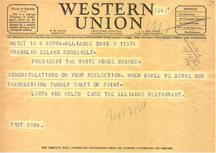
Recalcitrant Canada, I might add, does not recognize the fourth Thursday in November as Thanksgiving Day. I learned this the hard way while in college. Some friends and I decided to celebrate Thanksgiving by driving from Boston up to Montreal. It didn’t dawn on us that Canadians celebrate their Thanksgiving on the second Monday in October. This wouldn’t have been so bad, except that the restaurant in which we had our Thanksgiving dinner didn’t even have turkey on its menu. I had to settle for quiche, of all things. Now that’s a Thanksgiving travesty! (Picture: One of many critical communications Roosevelt received in light of his controversial Thanksgiving decision. This telegram, written in November 1940 by two restaurant owners reads: CONGRATULATIONS ON YOUR REELECTION. WHEN SHALL WE SERVE OUR THANKSGIVING TURKEY 21ST? OR 28TH?)
I want to close by printing the text of Lincoln’s original Thanksgiving proclamation. I won’t add my own comments. But I will italicize a few sections that strike me as especially profound. As you read this proclamation, you might ask yourself: What would happen if an American President used this kind of language today in an official proclamation? What in this statement speaks to the heart of our national crisis today?
Thanksgiving Proclamation of 1863
The year that is drawing toward its close has been filled with the blessings of fruitful fields and healthful skies. To these bounties, which are so constantly enjoyed that we are prone to forget the source from which they come, others have been added which are of so extraordinary a nature that they can not fail to penetrate and soften even the heart which is habitually insensible to the ever-watchful providence of Almighty God.
In the midst of a civil war of unequaled magnitude and severity, which has sometimes seemed to foreign states to invite and to provoke their aggression, peace has been preserved with all nations, order has been maintained, the laws have been respected and obeyed, and harmony has prevailed everywhere, except in the theater of military conflict, while that theater has been greatly contracted by the advancing armies and navies of the Union.
Needful diversions of wealth and of strength from the fields of peaceful industry to the national defense have not arrested the plow, the shuttle, or the ship; the ax has enlarged the borders of our settlements, and the mines, as well as the iron and coal as of our precious metals, have yielded even more abundantly than heretofore. Population has steadily increased notwithstanding the waste that has been made in the camp, the siege, and the battlefield, and the country, rejoicing in the consciousness of augmented strength and vigor, is permitted to expect continuance of years with large increase of freedom.
No human counsel hath devised nor hath any mortal hand worked out these great things. They are the gracious gifts of the Most High God, who, while dealing with us in anger for our sins, hath nevertheless remembered mercy.
It has seemed to me fit and proper that they should be solemnly, reverently, and gratefully acknowledged, as with one heart and one voice, by the whole American people. I do therefore invite my fellow-citizens in every part of the United States, and also those who are in foreign lands, to set apart and observe the last Thursday of November next as a day of thanksgiving and praise to our beneficent Father who dwelleth in the heavens. And I recommend to them that while offering up the ascriptions justly due to Him for such singular deliverances and blessings they do also, with humble penitence for our national perverseness and disobedience, commend to His tender care all those who have become widows, orphans, mourners, or sufferers in the lamentable civil strife in which we are unavoidably engaged, and fervently implore the imposition of the Almighty hand to heal the wounds of the nation and to restore it, as soon as may be consistent with the divine purpose, to the full enjoyment of peace, harmony, tranquility [sic], and union.
In testimony whereof I have hereunto set my hand and caused the seal of the United States to be affixed.
Done at the city of Washington, this 3d day of October, A. D. 1863, and of the Independence of the United States the eighty-eighth.
Topics: Thanksgiving | 2 Comments »
Finding the Heart of Thanksgiving
By Mark D. Roberts | Monday, November 23, 2009
As you know, on Thursday we celebrate Thanksgiving Day. Yet for many of us, that day is so full of activity that we actually have little time for intentional, extended giving thanks to God. So, as has been my tradition for many years, I will put up several posts in anticipation of Thanksgiving Day in order to encourage my readers to let this whole week by devoted to genuine gratitude.
When you think of Thanksgiving, what images come to mind? Roast turkey? Pumpkin pie? Watching football with your family? Perhaps the Macy’s Thanksgiving Day Parade?
 I grew up watching this parade on television, marveling at the giant helium balloon representations of Underdog and Bullwinkle, and waiting for Santa to appear to kick off the Christmas shopping season.
I grew up watching this parade on television, marveling at the giant helium balloon representations of Underdog and Bullwinkle, and waiting for Santa to appear to kick off the Christmas shopping season.
In 1982 I had the privilege of spending Thanksgiving Day in New York City. Of course I had to see the Macy’s Parade in person. There, standing alongside Central Park, I watched the bands and giant balloons from only a few feet away. I discovered that it was a lot colder watching the parade in person than from the comfortable vantage point of my living room. But plenty of hot coffee kept me going through the whole spectacle.
 That evening some friends and I had Thanksgiving dinner at the Helmsley Palace Hotel. (Yes, the one once owned and managed by the infamous Leona Helmsley and her husband.) We arrived an hour before our prearranged sitting and enjoyed appetizers in the hotel bar. It was the most elegant place I had ever enjoyed a drink and some peanuts. And, believe me, I paid for every inch of elegance. Thanksgiving dinner was served in the fabulously ritzy dining room. It was one of the most over-the-top meals of my life.
That evening some friends and I had Thanksgiving dinner at the Helmsley Palace Hotel. (Yes, the one once owned and managed by the infamous Leona Helmsley and her husband.) We arrived an hour before our prearranged sitting and enjoyed appetizers in the hotel bar. It was the most elegant place I had ever enjoyed a drink and some peanuts. And, believe me, I paid for every inch of elegance. Thanksgiving dinner was served in the fabulously ritzy dining room. It was one of the most over-the-top meals of my life.
But it still wasn’t quite right. After all, the heart of the Thanksgiving holiday isn’t going to parades or eating fancy meals. It’s about sharing a day with family, and mine was 3,000 miles away. The best tasting turkey in the most opulent dining room didn’t satisfy the real longing of my heart – to be home.
I wasn’t the only one who felt such a longing. In fact the Thanksgiving weekend is the busiest travel weekend of the year. The American Automobile Association predicts that 38.4 million people will travel at least 50 miles this year to celebrate Thankgiving with friends or relatives. (How in the world do they know that?)
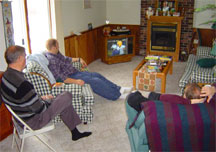 If you think about it, however, the actual events of Thanksgiving Day can be rather underwhelming. In addition to watching the Macy’s Parade, tens of millions of people (mostly men) watch football, while tens of millions of people (mostly women) cook mass quantities of traditional food. Then they all get together to eat more than they should, only to top off their gluttony with pumpkin or mince pie. Then there’s clean up, a bit more TV, and that just about sums up the day for many of us. It’s more about our stomachs than our hearts.
If you think about it, however, the actual events of Thanksgiving Day can be rather underwhelming. In addition to watching the Macy’s Parade, tens of millions of people (mostly men) watch football, while tens of millions of people (mostly women) cook mass quantities of traditional food. Then they all get together to eat more than they should, only to top off their gluttony with pumpkin or mince pie. Then there’s clean up, a bit more TV, and that just about sums up the day for many of us. It’s more about our stomachs than our hearts.
A college friend of mine named Jeff decided one year that his family’s Thanksgiving was far too secular. So Jeff, as a new Christian, volunteered to say the blessing before the meal. It was usually done perfunctorily by the most religious of the uncles, which wasn’t saying much in Jeff’s family. But Jeff was going to redeem Thanksgiving once and for all. So when it came time to pray, he started in thanking the Lord for the family’s many blessings. Then he turned to larger issues, expressing gratitude for freedom, for our country, and so on. Finally Jeff got explicitly religious, using his prayer as an opportunity to evangelize his godless relatives. After about five or six minutes, these godless relatives were about ready tar and feather Jeff. Finally his mother tapped his arm and said softly, “Honey, don’t you think it’s time to eat now?” In response to which the slightly religious uncle yelled, “Amen!” Jeff’s family immediately dug into the turkey, leaving Jeff somewhere mid-sentence.
Now I do not recommend Jeff’s evangelistic strategy. But I do appreciate his heart. Thanksgiving should be about more than a parade and pumpkin pie. In spite of the modern penchant for referring to the day as “Turkey Day,” it’s still meant to be a time for intentional gratitude. This was, as we’ll see in a later post, at the heart of Lincoln’s establishment of Thanksgiving Day as a national holiday in 1863.
Don’t worry. I’m not going to ask you to give up any of your prized Thanksgiving traditions. Go ahead and watch the parade and the games, if you wish. Drive several hours to grandma’s house and back. Eat way too much turkey. Take a long nap. Or whatever. These can be delightful traditions.
 But I am going to ask you not to forget the heart of Thanksgiving. In fact, I’m going to encourage you to let Thanksgiving be more than just a day. Why not take time this whole week to remember God’s blessings? If your Thanksgiving Day is already full with family folderol, then set aside some time on the day before or the day after to remember all that God has given, and to say “Thank you.” Better yet, do this for several minutes each day this week. If you do, not only will you be doing the right thing, since God deserves thanks for all he has done for you, but also you will find that your celebration of Thanksgiving is richer and fuller than you have imagined it could be.
But I am going to ask you not to forget the heart of Thanksgiving. In fact, I’m going to encourage you to let Thanksgiving be more than just a day. Why not take time this whole week to remember God’s blessings? If your Thanksgiving Day is already full with family folderol, then set aside some time on the day before or the day after to remember all that God has given, and to say “Thank you.” Better yet, do this for several minutes each day this week. If you do, not only will you be doing the right thing, since God deserves thanks for all he has done for you, but also you will find that your celebration of Thanksgiving is richer and fuller than you have imagined it could be.
Expressing heartfelt gratitude to God is one of life’s greatest joys. It’s a joy that many of us rarely experience. And it is the true heart of Thanksgiving. So let me invite you – yes, urge you – to take time this week for real expression of gratitude to God. You’ll be glad you did.
Note, if you’re having a sense of déjà vu as you read this post, you’re not crazy. This is a revised version of a post I put up a few years ago.
Topics: Thanksgiving | 8 Comments »
Sunday Inspiration from The High Calling
By Mark D. Roberts | Sunday, November 22, 2009
The Ingredients of Salvation
Unfailing love and truth have met together.
Righteousness and peace have kissed!
Usually, when Christians talk about salvation, we point to being saved from sin and death through the sacrifice of Jesus Christ. Salvation has to do with the promise of life after death. “Are you saved, brother?” means, “Have you believed in Jesus so that you can go to heaven when you die?”
Part of the good news of God’s salvation does indeed have to do with our life beyond the grave. But that’s only part of what salvation entails. There is still more! We see this in Psalm 85. Verse 9 affirms, “Surely [God’s] salvation is near to those who fear him.” Then verse 10 spells out some of what that salvation includes: “Unfailing love and truth have met together. Righteousness and peace have kissed!” When we are saved by God’s grace, his unfailing love embraces us forever. His truth fills our minds and transforms our hearts. Relationships are healed, and we live in peace with God and people. This peace is much more than simply the absence of conflict. Rather, it is life as God meant it to be, in which all people flourish in fellowship with God, people, and the earth.
When we put our faith in Jesus Christ, we not only receive reassurance about our eternal destiny. We also begin to experience the fullness of God’s salvation in this life. The Lord blesses us with his love and truth, with righteousness and peace. Moreover, we become agents of God in this world: sharing his love with others, speaking his truth, forming right relationships, and being peacemakers in all we do. The ingredients of salvation will not be fully mixed and baked until Christ comes again. But, in the meanwhile, we delight in those good gifts and are privileged to give them away to others. This, indeed, is part of our high calling!
QUESTIONS FOR REFLECTION: How have you experienced God’s salvation through Jesus Christ? How has your life been touched by God’s love, truth, righteousness, and peace? How might these ingredients of salvation make a difference in your life today?
PRAYER: How I thank you, dear Lord, for the gift of your salvation. Thank you for bearing my sin on the cross so that I might have eternal life, the life of the age to come.
Yet how wonderful that I don’t have to just sit around and wait to experience your salvation, Lord. Thank you for allowing me to begin to taste the ingredients of salvation today.
Thank you for your unfailing love that never lets me go. May I share your love with others today.
Thank you for your truth that makes sense of this life and helps me to live fruitfully. May I speak and live your truth today.
Thank you for the righteousness that enables me to have healthy relationships with people. May I live rightly with all whom I encounter today.
Thank you for your peace that touches every part of life, from the depth of my heart to the breadth of nations. May I enjoy and extend your peace today.
All praise be to you, God of my salvation, Savior of the world! Amen.
_________________________________________________
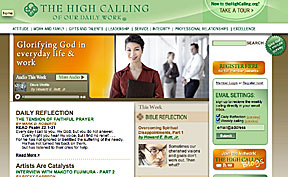 Would you like to receive a Daily Reflection like this one in your email inbox each morning?
Would you like to receive a Daily Reflection like this one in your email inbox each morning?
Here’s how . . . .
This devotional comes from The High Calling of Our Daily Work (www.thehighcalling.org), a wonderful website about work and God. You can read my Daily Reflections there, or sign up to have them sent to your email inbox each day. This website contains lots of encouragement for people who are trying to live out their faith in the workplace.
Topics: Sunday Inspiration | No Comments »
Photos from the Capitol
By Mark D. Roberts | Saturday, November 21, 2009
Yesterday, my family and I visited the Texas Capitol, the center of the state government in Austin, the capital. We were there for my daughter to be reconized for getting second place in the National History Day competition last summer. (She was second in the Junior Division, Individual Performance.) So, yesterday, the State Board of Education honored Kara and others from Texas who did well in the competition. I thought I’d share a couple of photos.
First, Kara and her fellow winners. Next to Kara in the blue jacket is her 8th grade history teacher, Mr. Bryan Degner. “Coach” Degner is an amazing teacher, whose commitment and willingness to invest hundreds of extra hours helped Kara to make it all the way to the national competition.
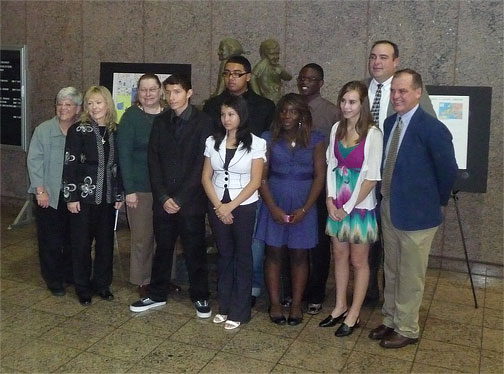
The Texas Capitol on a cloudy morning.
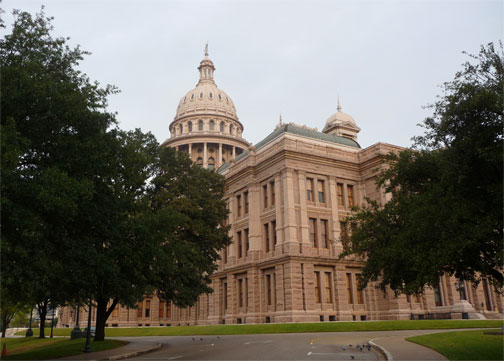
Inside of the dome, looking up.

Topics: Texas | 3 Comments »
Three Top Website Recommendations
By Mark D. Roberts | Friday, November 20, 2009
Today, I want to recommend three great websites. I have been visiting these websites for several years with great appreciation. I have recommended them before, but they’re worth another shout out.
This website offers thousands of photos of biblical sites. You name it, they’ll have it, and much, much more. But here’s the best part. For use in ministry or teaching contexts, you can use these fantastic photos for free. (Commercial uses require special permission, as do some website uses.)
Holy Land Photos is the brainchild of Dr. Carl Rasmussen, who is Professor of Biblical Studies at Bethel College, Minnesota. Carl is an expert in biblical archeology. He contributes both photos and commentary on this excellent website.
Presbyweb (also, Church and World.com)
Presbyweb collects valuable news stories of interest to Presbyterians. It now includes a United Methodist edition as well. There is no better place in the entire world to keep on on what’s happening in the PC(USA). Presbyweb, which is updated daily (except Sundays), is truly, literally “fair and balanced.” It includes stories from different sides of the church, treating all with respect.
Presbyweb and associated websites are the work of Han Cornelder, who is a PC(USA) pastor. He’s been doing this work for over ten years. Now I should mention that Presbyweb and the other Church and World sites are subscription sites. After a free trial, you’ll need to make a donation to the work. But, in my opinion, this is some of the best subscription money I pay each year. If you’re a leader in the Presbyterian or United Methdist churches (pastor, minister, elder, deacon, etc.), you need this invaluable service. (By the way, I should mention that I do not receive anything for this promotion. Hans is not a personal friend, though we have exchanged friendly emails and I have a great appreciation for his work. He does link to my website when he thinks I have something worthwhile for his audience, but we have no official quid pro quo.)
The High Calling of Our Daily Work
If you read my website very often, you know that Laity Lodge (where I work) and The High Calling.org are siblings. We share the same parent organization, the Foundations for Laity Renewal (formerly, the H.E. Butt Foundation). Moreover, you may know that I contribute to The High Calling.org, writing the Daily Reflections that appear on the site and are emailed to thousands of people each morning. So I am not fully objective about this website.
But, I should add that I was a fan of The High Calling.org before joined the staff of Laity Lodge. In fact, my excitement for this work was one of the major factors that God used to draw me to Texas. The High Calling.org seeks to use the Internet to encourage Christians to live our their faith in daily life, especially in their workplace. This is “the high calling of our daily work.”
The High Calling.org features content that changes weekly, at least. My Daily Reflections change daily. The content includes Bible studies, interviews, thematic articles, etc. And because The High Calling.org is supported by Foundations for Laity Renewal, it is able to give away its material (almost all of the time). So if you’re looking for some excellent resources, either for yourself, or a small group, or an adult Sunday School class, check out The High Calling.org. You’ll be glad you did.
Topics: Recommendations | 1 Comment »
Laity Lodge on Worship Team Training
By Mark D. Roberts | Thursday, November 19, 2009
Worship Team Training is a ministry that provides inspiration, training, and resources for worship leaders, especially but not only those who lead in contemporary contexts. Worship Team Training offers a whole-person approach to the training of worship leaders, focusing on skill development, leadership growth, and spiritual renewal.
Worship Team Training was begun by Branon Dempsey, a mature, visionary worship leader whom I met when teaching in the Southern California Worship Institute some years ago. Branon had enrolled in the Institute to develop his talent as a worship leader, especially to grow in his theological understanding of worship. Since our first meeting, Branon and I have continued in dialogue over a theology of worship. When I moved to Texas, where Branon lived, we were able to reconnect at Laity Lodge.
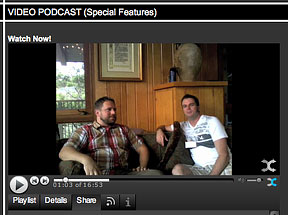 Right now the Worship Team Training website features a couple of Laity Lodge related items. The first is a video interview of Brian Moss that was done in the Great Hall of Laity Lodge. Brian is a gifted songwriter/musician/worship leader, who is now serving as the Chapel Coordinator for Regent College in Vancouver. Here’s the link to the Brian Moss interview.
Right now the Worship Team Training website features a couple of Laity Lodge related items. The first is a video interview of Brian Moss that was done in the Great Hall of Laity Lodge. Brian is a gifted songwriter/musician/worship leader, who is now serving as the Chapel Coordinator for Regent College in Vancouver. Here’s the link to the Brian Moss interview.
The second item on the Worship Team Training website is an interview Branon did with yours truly a couple of months ago. We talk about the theology of worship among other things. My interview is part of an hour-long podcast, which you can stream or download from the Worship Team Training website, or from iTunes. My part of the podcast begins at about 32 minutes in.
If you’re a worship leader, I highly recommend that you check out the resources at Worship Team Training. If you’re not a worship leader but know someone who is, please tell them about this fine ministry. As you can imagine, I’m especially thankful for the high value placed on biblical theology in this ministry.
Topics: Worship | 1 Comment »
Fall in the Texas Hill Country, Part 2
By Mark D. Roberts | Wednesday, November 18, 2009
Here are a couple more photos, taken at Laity Lodge last weekend. Enjoy!
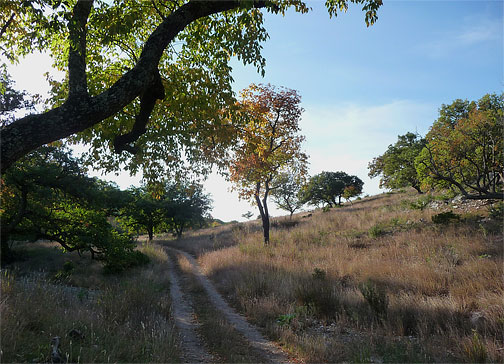
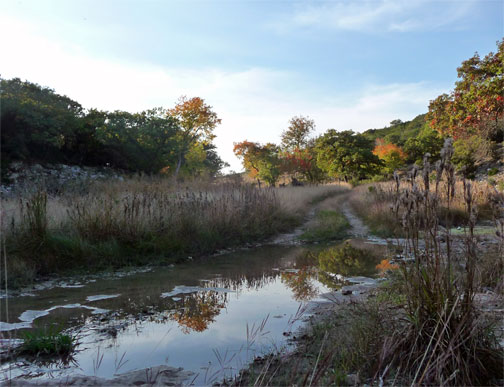
Topics: Laity Lodge | 1 Comment »


